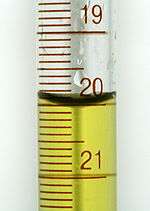Meniscus (liquid)

B: The top of a convex meniscus.
The meniscus (plural: menisci, from the Greek for "crescent") is the curve in the upper surface of a liquid close to the surface of the container or another object, caused by surface tension. It can be either concave or convex, depending on the liquid and the surface.
A concave meniscus occurs when the particles of the liquid are more strongly attracted to the container (adhesion) than to each other (cohesion), causing the liquid to climb the walls of the container. This occurs between water and glass. Water-based fluids like sap, honey, and milk also have a concave meniscus in glass or other wettable containers.
Conversely, a convex meniscus occurs when the particles in the liquid have a stronger attraction to each other than to the material of the container.[1] Convex menisci occur, for example, between mercury and glass in barometers[1] and thermometers.
The meniscus and measurement

When reading a depth scale on the side of an instrument filled with liquid, such as a water level device, the meniscus must be taken into account in order to obtain an accurate measurement. Depth must be measured with the meniscus at eye level (to eliminate parallax error) and at the center of the meniscus, i.e. the top of a convex meniscus or the bottom of a concave meniscus.
Manufacturers of glassware and other tools calibrate their measurement marks to account for the meniscus. This means that any instrument is calibrated for a specific liquid, usually water.
Capillary action
Menisci are a manifestation of capillary action, by which surface adhesion pulls a liquid up to form a concave meniscus or internal cohesion pulls the liquid down to form a convex meniscus. This phenomenon is important in transpirational pull in plants. When a tube of a narrow bore, often called a capillary tube, is dipped into a liquid and the liquid wets the tube (with zero contact angle), the liquid surface inside the tube forms a concave meniscus, which is a virtually spherical surface having the same radius, r, as the inside of the tube. The tube experiences a downward force of magnitude 2πrσ, where σ is the surface tension of the liquid.[2]
References
- 1 2 Moore, John W.; Stanitski, Conrad L.; Jurs, Peter C. (2005). Chemistry: The Molecular Science. Belmont, CA: Brooks/Cole. p. 290.
- ↑ "Fluid Mechanics". Encyclopedia Britannica. Retrieved 14 November 2014.